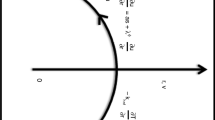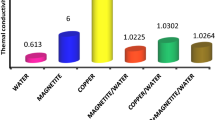Abstract
Unsteady squeezed flow of hybrid nanofluid is investigated in this analysis. Comparison of hybrid nanofluid (using CNTs + CuO) and nanofluid (using CNTs) is emphasized. Water is considered as basefluid. Melting effect and viscous dissipation describe heat transfer features. Entropy production and Bejan number are addressed. Relevant flow expressions (PDEs) are transmitted into ODEs through suitable transformations. By means of numerical method (shooting technique with RK-4 algorithm), the obtained ODEs are solved. Comparative study of basefluid (water), hybrid nanofluid (using CNTs + CuO) and nanofluid (using CNTs) is performed for impacts of involved flow parameters on entropy production rate, velocity, Bejan number and temperature. Further comparative analysis of basefluid (water), hybrid nanofluid (using CNTs + CuO) and nanofluid (using CNTs) is done through numerical evaluation of Nusselt number. Velocity of fluid intensifies for larger values of squeezing parameter, nanoparticle volume fraction for single-walled CNTs or multi-walled CNTs, melting parameter and nanoparticle volume fraction for copper oxide in case of both nanofluid and hybrid nanofluid flow. Temperature of fluid enhances with increment in Eckert number while it can be controlled via larger nanoparticle volume fraction for single-walled CNTs or multi-walled CNTs, squeezing parameter, melting parameter and nanoparticle volume fraction for copper oxide. Rate of heat transfer or Nusselt number increases with larger estimation of squeezing parameter, nanoparticle volume fraction for copper oxide, melting parameter and nanoparticle volume fraction for single-walled CNTs or multi-walled CNTs. Entropy production rate is higher for squeezing parameter, melting parameter and Eckert number. Bejan number is reduced with melting parameter while it increases for larger squeezing parameter and Eckert number. During comparative analysis, the performance of hybrid nanofluid is efficient.











Similar content being viewed by others
Abbreviations
- u, v :
-
Components of velocity
- x, y :
-
Cartesian coordinate system
- μ f :
-
Fluid dynamic viscosity
- ν f :
-
Kinematic fluid viscosity
- ρ f :
-
Fluid density
- k f :
-
Fluid thermal conductivity
- α f :
-
Thermal diffusivity of fluid
- f ′ :
-
Non-dimensional velocity
- θ :
-
Non-dimensional temperature
- T f :
-
Temperature of hot fluid
- T m :
-
Melting surface temperature
- Ecx :
-
Local Eckert number
- CNTs:
-
Carbon nanotubes
- SWCNTs:
-
Single-walled CNTs
- (c p)f :
-
Specific heat of fluid
- Pr :
-
Prandtl number
- τ xy :
-
Shear stress
- ϕ 1 :
-
CNTs volume fraction
- p :
-
Pressure
- Sq:
-
Squeezing parameter
- M :
-
Melting parameter
- Ec:
-
Eckert number
- k CNT :
-
Thermal conductivity of CNTs
- k CuO :
-
Thermal conductivity of CuO
- MWCNTs:
-
Multiple-walled CNTs
- CuO:
-
Copper oxide
- ϕ 2 :
-
CuO volume fraction
- μ hnf :
-
Dynamic viscosity
- ν hnf :
-
Kinematic viscosity
- ρ hnf :
-
Density
- k hnf :
-
Thermal conductivity
- α hnf :
-
Thermal diffusivity
- (c p)hnf :
-
Specific heat
- k nf :
-
Thermal conductivity
- α nf :
-
Thermal diffusivity
- (c p)nf :
-
Specific heat
- μ nf :
-
Dynamic viscosity
- ν nf :
-
Kinematic viscosity
- ρ nf :
-
Density
References
Choi SUS, Eastman JA (1995) Enhancing thermal conductivity of fluids with nanoparticles. In: The proceedings of the 1995 ASME international mechanical engineering congress and exposition, San Francisco, USA, ASME, FED 231/MD, vol 66, pp 99–105.
Hayat T, Muhammad K, Muhammad T, Alsaedi A. Melting heat in radiative flow of carbon nanotubes with homogeneous-heterogeneous reactions. Commun Theror Phys. 2018;69:441–8.
Hosseini SR, Ghasemian M, Sheikholeslami M, Shafee A, Li Z. Entropy analysis of nanofluid convection in a heated porous microchannel under MHD field considering solid heat generation. Powder Technol. 2019;344:914–25.
Hayat T, Muhammad K, Alsaedi A, Asghar S. Numerical study for melting heat transfer and homogeneous-heterogeneous reactions in flow involving carbon nanotubes. Results Phys. 2018;8:415–21.
Khan MI, Kumar A, Hayat T, Waqas M, Singh R. Entropy generation in flow of Carreau nanofluid. J Mol Liq. 2019;278:677–87.
Dinarvand S, Pop I. Free-convective flow of copper/water nanofluid about a rotating down-pointing cone using Tiwari-Das nanofluid scheme. Adv Powder Technol. 2017;28:900–9.
Hayat T, Ahmed B, Abbasi FM, Alsaedi A. Hydromagnetic peristalsis of water based nanofluids with temperature dependent viscosity: a comparative study. J Mol Liq. 2017;234:324–9.
Muhammad K, Hayat T, Alsaedi A. Squeezed flow of Jeffrey nanomaterial with convective heat and mass conditions. Phys Scr. 2019. https://doi.org/10.1088/1402-4896/ab234f.
Mahian O, Kolsi L, Amani M, Estellé P, Ahmadi G, Kleinstreuer C, Marshall JS, Siavashi M, Taylor RA, Niazmand H, Wongwises S, Hayat T, Kolanjiyil A, Kasaeian A, Pop I. Recent advances in modeling and simulation of nanofluid flows-Part I: fundamentals and theory. Phys Rep. 2018. https://doi.org/10.1016/j.physrep.2018.11.004.
Hayat T, Muhammad K, Farooq M, Alsaedi A. Melting heat transfer in stagnation point flow of carbon nanotubes towards variable thickness surface. AIP Adv. 2016;6:015214.
Bahiraei M, Heshmatian S. Electronics cooling with nanofluids: a critical review. Energy Convers Manag. 2018;172:438–56.
Alsaadi FE, Muhammad K, Hayat T, Alsaedi A, Asghar S. Numerical study of melting effect with entropy generation minimization in flow of carbon nanotubes. Journal of Thermal Analysis and Calorimetery. 2019. https://doi.org/10.1007/s10973-019-08720-9.
Chamkha AJ, Molana M, Rahnama A, Ghadami F. On the nanofluids applications in microchannels: a comprehensive review. Powder Technol. 2018;332:287–322.
Hayat T, Muhammad K, Alsaedi A, Farooq M. Features of Darcy-Forchheimer flow of carbon nanofluid in frame of chemical species with numerical significance. J. Cent. South Univ. 2019;26:1260–70.
Molana M. On the nanofluids application in the automotive radiator to reach the enhanced thermal performance: a review. American Journal of Heat and Mass Transfer. 2017;4:168–87.
Mahian O, Kianifar A, Kalogirou SA, Pop I, Wongwises S. A review of the applications of nanofluids in solar energy. Int J Heat Mass Transf. 2013;57:582–94.
Khan MI, Muhammad K, Hayat T, Farooq S, Alsaedi A. Numerical treatment for Darcy-Forchheimer flow of carbon nanotubes due to convectively heat nonlinear curved stretching surface. Int J Numer Meth Heat Fluid Flow. 2019. https://doi.org/10.1108/hff-01-2019-0016.
Kasaeian A, Daneshazarian R, Mahian O, Kolsi L, Chamkha AJ. Nanofluid flow and heat transfer in porous media: a review of the latest developments. Int J Heat Mass Transf. 2017;107:778–91.
Molana M. A comprehensive review on the nanofluids application in the tubular heat exchangers. Am J Heat Mass Transf. 2016;3:352–81.
Sarkar J, Ghosh P, Adil A. A review on hybrid nanofluids: recent research, development and applications. Renew Sustain Energy Rev. 2015;43:164–77.
Sajid MU, Ali HM. Thermal conductivity of hybrid nanofluids: a critical review. Int J Heat Mass Transf. 2018;126:211–34.
Huminic G, Huminic A. The influence of hybrid nanofluids on the performances of elliptical tube: recent research and numerical study. Int J Heat Mass Transf. 2019;129:132–43.
Hayat T, Nadeem S. Heat transfer enhancement with Ag-CuO/water hybrid nanofluid. Results in Physics. 2017;7:2317–24.
Sun B, Zhang Y, Yang D, Li H. Experimental study on heat transfer characteristics of hybrid nanofluid impinging jets. Appl Therm Eng. 2019;151:556–66.
Muhammad K, Hayat T, Alsaedi A, Asghar S. Stagnation point flow of basefluid (gasoline oil), nanomaterial (CNTs) and hybrid nanomaterial (CNTs + CuO): a comparative study. Material Research Express. 2019. https://doi.org/10.1088/2053-1591/ab356e.
Stefan MJ. Versuch ber die scheinbare adhesion. Akad Wissensch Wien Math Natur. 1874;69:713.
Hayat T, Muhammad K, Ullah I, Alsaedi A, Asghar S. Rotating squeezed flow with carbon nanotubes and melting heat. Phys Scr. 2018. https://doi.org/10.1088/1402-4896/aaef66.
Singeetham PK, Puttanna VK. Viscoplastic fluids in 2D plane squeeze flow: a matched asymptotics analysis. J Nonnewton Fluid Mech. 2019;263:154–75.
Ahmad S, Farooq M, Javed M, Anjum A. Slip analysis of squeezing flow using doubly stratified fluid. Results Phys. 2018;9:527–33.
Hayat T, Muhammad K, Farooq M, Alsaedi A. Unsteady squeezing flow of carbon nanotubes with convective boundary conditions. PLoS ONE. 2016;11:0152923.
Sobamowo MG, Akinshilo AT. On the analysis of squeezing flow of nanofluid between two parallel plates under the influence of magnetic field. Alex Eng J. 2018;57:1413–23.
Hayat T, Muhammad K, Farooq M, Alsaedi A. Squeezed flow subject to Cattaneo–Christov heat flux and rotating frame. J Mol Liq. 2016;220:216–22.
Sobamowo MG, Jayesimi LO, Waheed MA. Magnetohydrodynamic squeezing flow analysis of nanofluid under the effect of slip boundary conditions using variation of parameter method. Karbala Int J Mod Sci. 2018;4:107–18.
Hayat T, Muhammad K, Alsaedi A, Asghar S. Thermodynamics by melting in flow of an Oldroyd-B material. J Braz Soc Mech Sci Eng. 2018;40:530. https://doi.org/10.1007/s40430-018-1447-3.
Farooq M, Ahmad S, Javed M, Anjum A. Melting heat transfer in squeezed nanofluid flow through Darcy Forchheimer medium. ASME J Heat Transf. 2018;10(1115/1):4041497.
Author information
Authors and Affiliations
Corresponding author
Additional information
Publisher's Note
Springer Nature remains neutral with regard to jurisdictional claims in published maps and institutional affiliations.
Rights and permissions
About this article
Cite this article
Muhammad, K., Hayat, T., Alsaedi, A. et al. Melting heat transfer in squeezing flow of basefluid (water), nanofluid (CNTs + water) and hybrid nanofluid (CNTs + CuO + water). J Therm Anal Calorim 143, 1157–1174 (2021). https://doi.org/10.1007/s10973-020-09391-7
Received:
Accepted:
Published:
Issue Date:
DOI: https://doi.org/10.1007/s10973-020-09391-7




